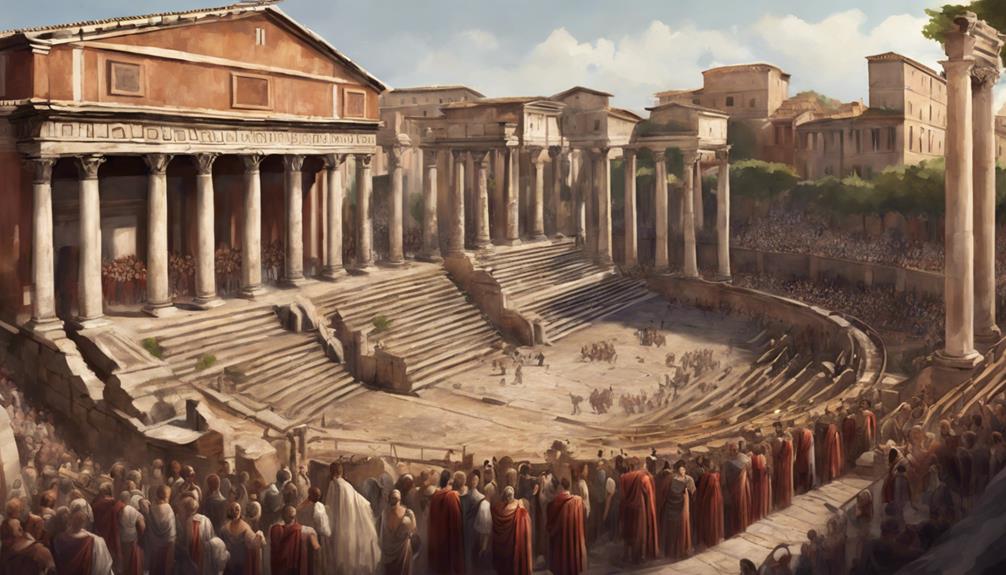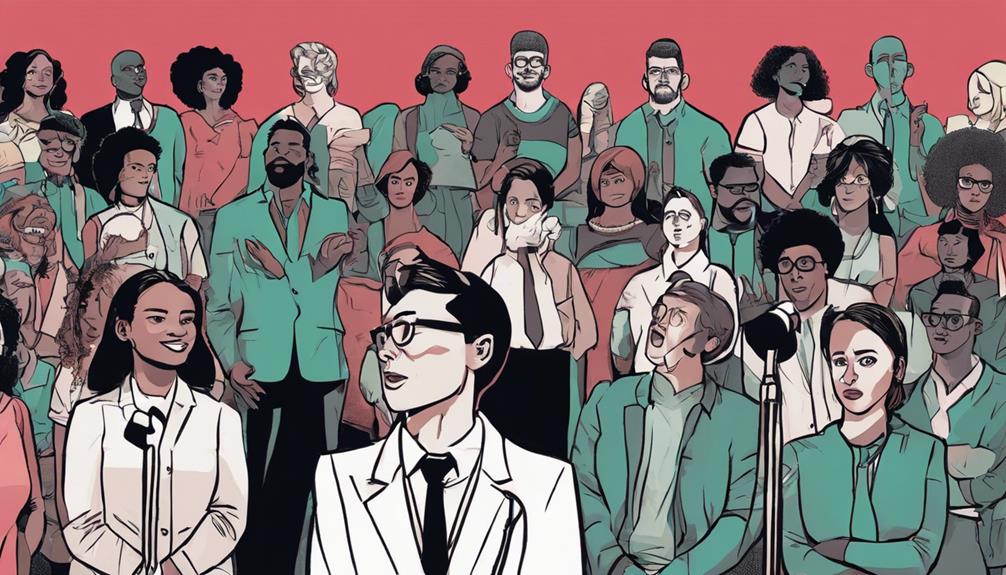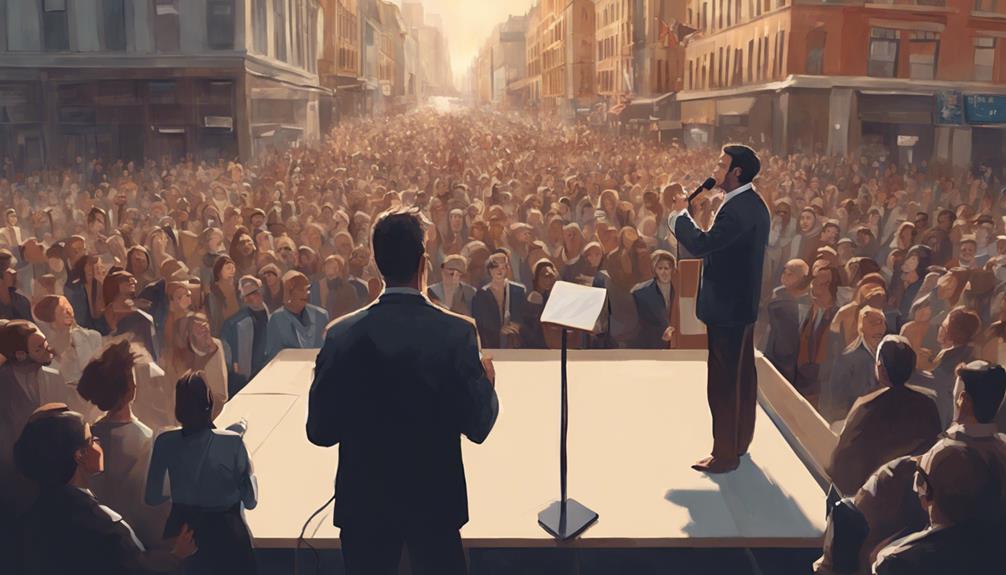Explore how the Rostra played a pivotal role in Roman public speaking, shaping political discourse and authority. From Antony's speeches to Diocletian's reign, the Rostra symbolized power and influenced public opinion, showcasing Roman governance dynamics. The surrounding artifacts and monuments near the Rostra highlight its significance in commemorating leaders like Trajan and Hadrian. Learn how this architectural symbol not only cemented Roman authority but also laid the groundwork for modern speaker podiums. Its historical impact in governance and communication remains profound, bridging the ancient past with contemporary practices.
Key Takeaways
- Rostra was a platform for political speeches in the Roman Republic.
- It symbolized power and authority, shaping public opinion.
- Famous speeches like Antony's funeral orations were delivered there.
- The Rostra influenced governance shifts and communication dynamics.
- Its architectural features and legacy coined the term 'rostrum' for speaker podiums.
Rostra's Origin and Design
The Rostra, a platform for orators in ancient Rome, was named after the bronze ships beaks adorning it. Originally planned by Julius Caesar and completed by Augustus in 42 BC, it featured vertical slots and large dowel holes. This platform played a significant role in the political landscape of the Roman Republic. Antony delivered his famous funeral speech for Caesar from the Rostra, setting the stage for many other political events and speeches by prominent figures in history. The design of the Rostra, with its intricate details and historical significance, reflects its importance in Roman public speaking and political activities.
The Rostra wasn't merely a physical structure but a symbol of power and influence in the Roman Republic. Diocletian himself celebrated his reign's anniversaries at the Rostra in AD 303, leaving a lasting mark by erecting five honorary columns during his visit. This platform stood as a representation of the eloquence and authority of those who stood upon it, shaping the course of Roman history through persuasive speeches and political discourse.
Historical Significance of the Rostra
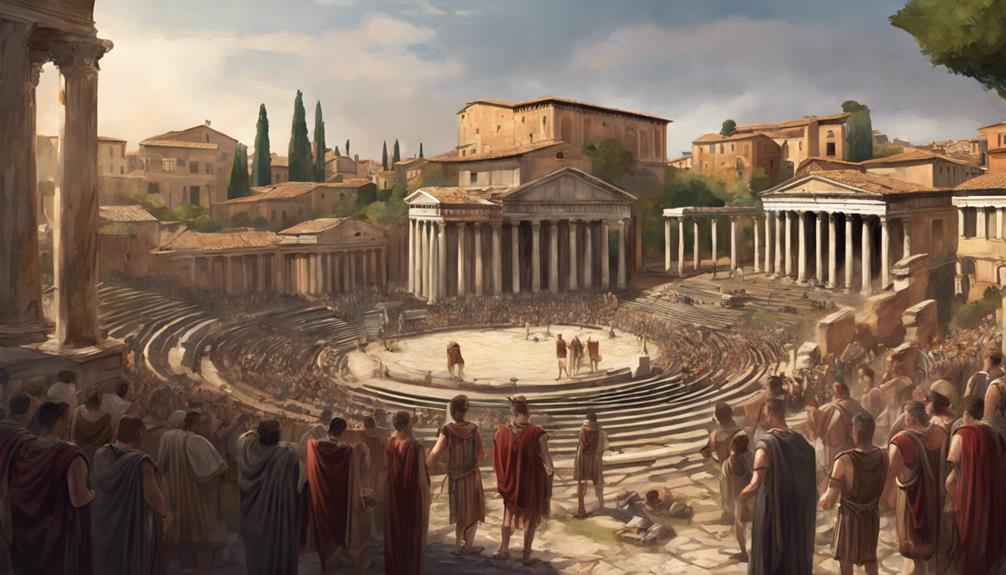
The Rostra holds immense historical significance in Roman public speaking, as it served as a platform for political speeches that influenced public discourse.
Over time, the Rostra became a symbol of power and authority, shaping the political landscape of the Roman Republic.
Its pivotal role in political and judicial activities, including high-profile trials and speeches by influential figures like Julius Caesar and Brutus, solidified its place in Roman history.
Political Speeches at Rostra
Antony's delivery of his famous funeral speech for Caesar marks a pivotal moment in Roman history, showcasing the Rostra's enduring influence on political addresses. The Rostra, a platform prominently used for public speeches, witnessed significant political events like the Triumvirs pronouncing sentences on their enemies, including Cicero. In AD 303, Diocletian's commemoration of his reign's anniversaries at the Rostra emphasized its lasting importance in Roman politics. During Diocletian's visit, the Rostra featured honorary columns, with only one decorated column base remaining today as a symbol of its historical significance.
Political addresses at the Rostra played a vital role in shaping Rome's public discourse and power dynamics. The platform served as a stage for influential orators to sway the opinions of the Roman populace and make lasting political statements. Through emotive and persuasive speeches delivered at the Rostra, leaders could rally support, condemn adversaries, and assert their authority in the turbulent political landscape of ancient Rome.
Influence on Public Discourse
An essential hub for public dialogue and political rhetoric, the Rostra stood as a symbol of authority and influence in ancient Rome. It was at this revered platform that significant speeches, such as Antony's funeral oration for Caesar and the proscriptions by the Triumvirs, resonated through the hearts of the Roman citizens.
The Rostra's historical significance went beyond mere speeches; it embodied power and legitimacy in the Roman Republic, shaping the course of public discourse.
Following Caesar's assassination, Brutus and Cassius utilized the Rostra to convey their message to the Roman people, emphasizing the pivotal role this platform played in communicating political ideologies. Additionally, the Rostra's relocation by Caesar and subsequent modifications by Augustus signified pivotal shifts in Roman governance, illustrating how this structure continued to influence public discourse even as Rome transformed into an empire under Augustus' rule.
The Rostra's enduring legacy as a site for political expression underscores its profound impact on shaping public discourse in ancient Rome.
Artifacts and Decorations Near the Rostra
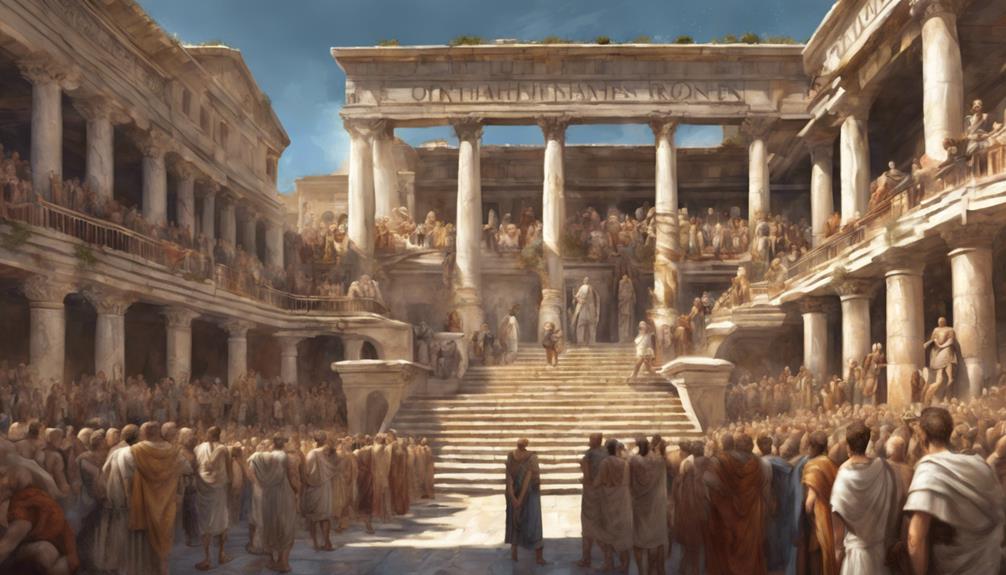
Near the Rostra, you'll find intriguing marble reliefs believed to date back to the time of Hadrian, potentially serving as a balustrade or parapet.
These reliefs, while missing the heads of key figures, commemorate the social programs of Trajan and actions by Hadrian, offering a glimpse into the past political discourse of ancient Rome.
The artifacts and decorations surrounding the Rostra not only reflect historical significance but also contribute to the architectural charm of the area, emphasizing its crucial role in shaping public speaking and political events in Roman society.
Marble Reliefs Discovery
The discovery of two marble reliefs near the Rostra in Rome reveals intriguing insights into the artistic and historical significance of these artifacts.
These marble reliefs, identified as Anaglypha, are believed to originate from the era of Hadrian, potentially serving as a balustrade or parapet near the Rostra. They bear depictions commemorating the social initiatives of Trajan and the actions of Hadrian during their respective reigns.
Despite the detailed scenes depicted, the heads of the primary figures are conspicuously absent, adding an enigmatic quality to their interpretation. Revealing these reliefs near the Rostra provides a window into the decorative and artistic elements that adorned this prominent platform in ancient Rome.
The intricate carvings and historical themes captured in the marble reliefs offer valuable insights into the visual culture and commemorative practices of the time, enriching our understanding of the intersection between art, history, and public spaces in ancient Rome.
Trajan and Hadrian
The marble reliefs near the Rostra, discovered to likely hail from the era of Hadrian, showcase depictions of Trajan's social programs and Hadrian's actions, with the enigmatic absence of the heads of prominent figures adding depth to their historical allure.
These artifacts, believed to date back to the reigns of Trajan and Hadrian, offer a fascinating glimpse into the past.
Here are some intriguing details about these reliefs:
- Depictions of Trajan's social policies and Hadrian's deeds are prominently featured.
- The missing heads of principal figures on the reliefs create a sense of mystery and intrigue.
- These marble artifacts were found near the Rostra, possibly serving as balustrades or decorative elements.
- The reliefs, originating during the Hadrianic period, provide valuable insights into Roman governance and public life.
- The scenes portrayed on these reliefs offer a visual narrative of the contributions made by Trajan and Hadrian to Roman society.
Missing Figure Heads
Investigating the enigmatic absence of heads on the marble reliefs near the Rostra reveals a layer of mystery surrounding their significance and historical context. These Roman artifacts, potentially dating back to Hadrian's era, were likely part of a balustrade or parapet near the Rostra.
Depicting Trajan's social initiatives and Hadrian's deeds, the reliefs serve as a commemoration of significant events. The missing heads of the principal figures on these reliefs add an intriguing element, prompting questions about the original intent and symbolism behind them. The absence of these pivotal features raises queries about whether it was intentional or a result of damage over time.
Scholars are left to ponder the implications of these missing figure heads, leading to debates about the messages these reliefs were meant to convey and the impact of their incomplete state on our understanding of Roman history and culture.
Surrounding Monuments of the Rostra

Surrounded by significant monuments, the Rostra in ancient Rome stood as proof of the city's historical and architectural prominence. The surrounding monuments added to the grandeur of the Rostra and played a pivotal role in the city's public speaking events.
Here are some key monuments that enhanced the importance of the Rostra:
- Umbilicus Romae: Symbolized the official center of Rome and the Roman world, located at the north end of the Rostra.
- Milliarium Aureum: Erected by Augustus in 20 BC near the Rostra, sheathed in gilded bronze, serving as a convergence point for roads leading to Rome.
- Diocletian's Columns: Five honorary columns were erected behind the Rostra by Diocletian in AD 303, with only one decorated column base remaining today.
- Inscriptions on the Milliarium Aureum: Showcased distances from major cities of the empire, symbolizing the central point of the Roman road system.
- Historical and Architectural Significance: The Rostra's location and surrounding monuments reflected its importance in ancient Rome, serving as a focal point for speeches and political events.
Inscriptions and Symbolism at the Rostra
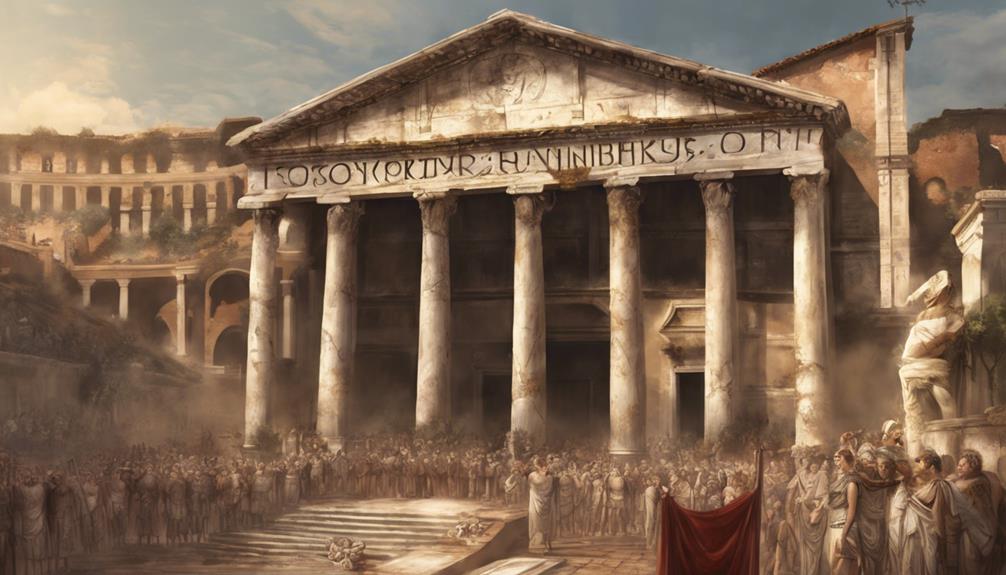
Enhancing the historical significance of the Rostra, the inscriptions and symbolism at this ancient Roman platform served as powerful markers of Rome's expansive reach and authority. The inscriptions on the Milliarium Aureum, a gilded column placed nearby, featured the major cities of the Roman Empire along with their distances from Rome. This not only showcased the vastness of Rome's territories but also emphasized the interconnectedness facilitated by the Roman road system, with the Rostra symbolizing the central point of this network. The inscriptions on the Rostra itself further reinforced Rome's dominance and control over its vast empire, serving as visible reminders of Rome's power and influence. The symbolism embedded in these inscriptions played a crucial role in projecting Rome's authority in the ancient world.
| Inscriptions on the Rostra | Significance | Visual Representation |
|---|---|---|
| Major cities of the Roman Empire | Highlighted Rome's extensive territorial control | Map of the Roman Empire |
| Distances from Rome | Emphasized the connectivity of the Roman road system | Mileage markers |
| Symbols of Roman power and authority | Reinforced Rome's dominance over its territories | Imperial insignias |
Architectural Features of the Rostra
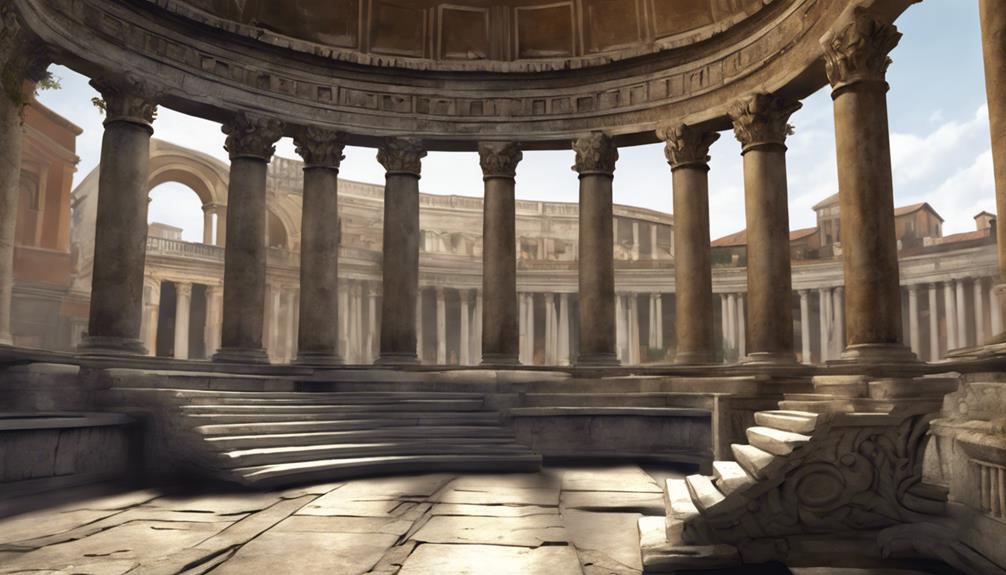
The architectural features of the Rostra in ancient Rome were integral to its role as a platform for public speeches and displays, closely linked to the Senate Curia. Here are some key aspects of the Rostra's design:
- Elevated Position: Positioned facing the Senate house in the Comitium, the Rostra provided a raised platform for speakers to address the populace, ensuring visibility and amplification of their voices.
- Symbol of Authority: The Rostra's design symbolized power and authority in ancient Roman governance, emphasizing the importance of public speaking in political discourse.
- Evolutionary Design: Over time, the Rostra's design and location changed to reflect the evolving nature of Roman political institutions and the shifting dynamics of power.
- Historical Significance: Speakers like Brutus and Cassius utilized the Rostra to address the crowd following Caesar's assassination, underscoring its pivotal role in shaping key historical events.
- Political Theater: The Rostra's architecture facilitated dramatic public displays and speeches, enhancing the theatrical element of political discourse in ancient Rome.
Legacy and Influence of the Rostra
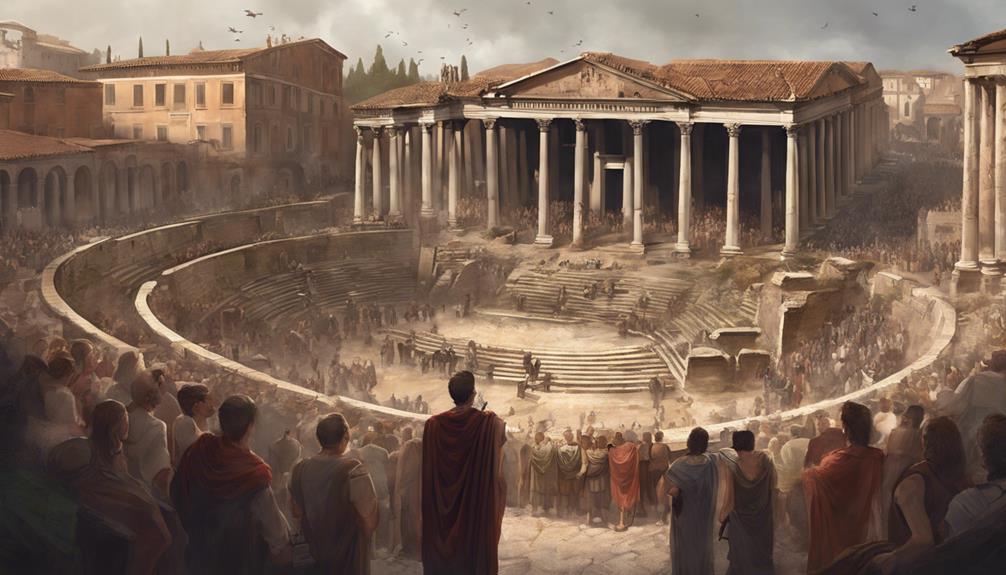
The enduring legacy of the Rostra in ancient Rome lies in its profound influence on public speaking and political discourse, shaping the very fabric of Roman governance and communication.
The term 'rostrum' for a speaker's podium originates from the Rostra's historical significance in Republican Rome, symbolizing power dynamics and political struggles. The Rostra's various restorations and alterations reflected the changing political landscape and played a pivotal role in late Republican Rome.
Its relocation by Julius Caesar and modifications by Augustus marked significant shifts in Roman governance and public speaking traditions, further solidifying its impact.
The Rostra's presence in Rome's historical landscape serves as a reminder of its lasting influence on public discourse and political events. As a platform for speeches and displays, the Rostra played an integral role in shaping Roman political institutions and public communication, leaving an indelible mark on the course of Republican Rome.
Rostra Vetera and Other Rostra
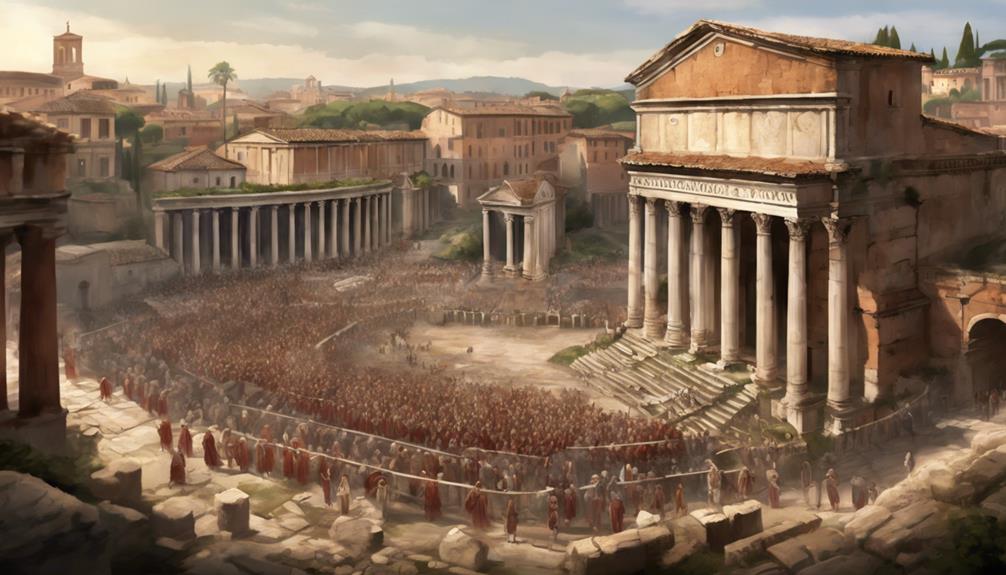
Dating back to the 6th century BC, the original Rostra, known as Rostra Vetera, underwent multiple reconstructions over time. Here are some key points about Rostra Vetera and other Rostra:
- Caesar's Rostra was located on the southwest side of the new Julian Forum, signifying a notable shift in its placement.
- Augustus commissioned a new Rostra in 29 BC, embellished with prows from ships captured at the Battle of Actium.
- The Rostra held significant religious and historical importance, being consecrated as a templum by the Augurs.
- Changes in Rostra locations and designs over time mirror the evolving political landscape and governance in ancient Rome.
Modern Relevance and Additional Information
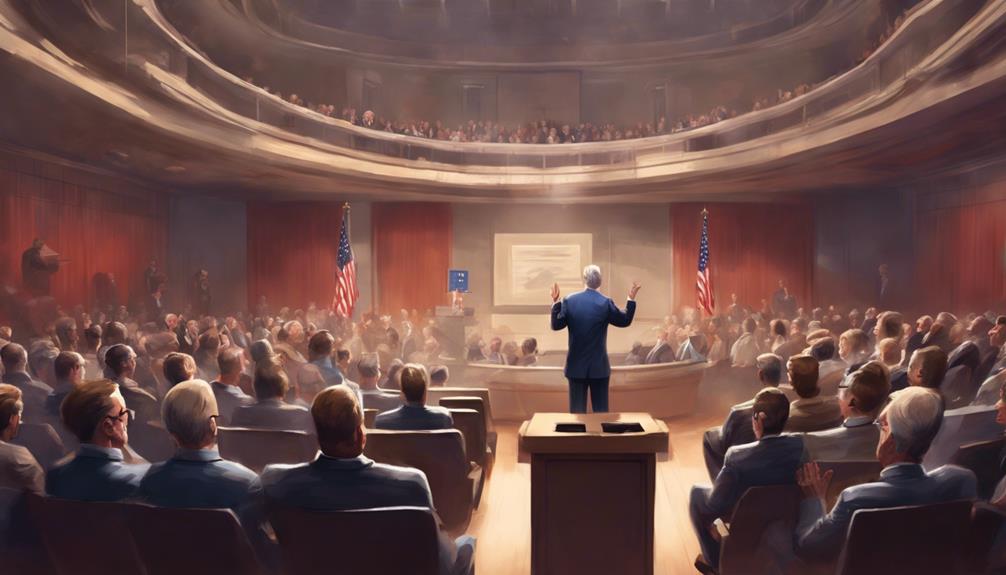
Exploring the modern importance of the Rostra involves understanding its lasting significance amidst contemporary preservation efforts and scholarly engagements with ancient Roman history.
Despite facing challenges like the 2008 heavy rain damaging the Vulcanal's monuments, preservation initiatives, such as Professor Angelo Bottini's awning, have been essential in safeguarding these ancient relics.
Tourists now have access options to view the original suggestum near the Rostra, a rare opportunity after 50 years. References to the Rostra in portals dedicated to ancient Rome and the works of various scholars underscore its historical significance.
Additionally, academic sources delve into Roman history, architecture, and politics, offering detailed insights into the Rostra's role in shaping public speaking in ancient Rome.
Frequently Asked Questions
Why Was the Rostra Important to the Romans?
The Rostra was vital to Romans, symbolizing power and authority. It served as a platform for magistrates, politicians, and orators to address the public in the heart of Rome. Julius Caesar relocated it for enhanced visibility.
How Did Romans Use Rostra to Show Their Power?
To show power, Romans used the Rostra as a grand stage, making speeches that swayed crowds, displayed authority, and cemented influence. From that platform, leaders commanded attention, communicated policies, and shaped public opinion.
What Were Orators in Ancient Rome?
Orators in ancient Rome were skilled speakers who delivered speeches to inform, persuade, or entertain. They addressed political, legal, or social issues from platforms like the Rostra in the Roman Forum, showcasing their influence and eloquence.
Who Was the Best Public Speaker in Ancient Rome?
In Ancient Rome, the best public speaker was Cicero. His eloquence and persuasive skills set him apart, engaging audiences. Julius Caesar and Mark Antony were also notable speakers, each with their unique styles and charisma.
How Did Ancient Orators Use the Rostra in Roman Public Speaking?
Ancient orators utilized the Rostra in Roman public speaking by following the golden rules of public speaking. They employed powerful delivery, utilized gesture and body language effectively, and maintained strong eye contact with their audience. These techniques helped them captivate and persuade the crowds gathered at the Rostra.
Conclusion
So there you have it, the fascinating world of ancient orators and the pivotal role the Rostra played in Roman public speaking. From its origins to its legacy, the Rostra has stood the test of time as a symbol of power and influence.
As they say, all roads lead to Rome, and in this case, all speeches led to the Rostra.
Keep exploring history's hidden gems, you never know what you might discover!

